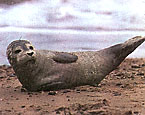|
Harbor
Seal
(Phoca vitulina) #61-515 |
||||
|
|
Physical
characteristics and distribution
|
|
The
Harbor Seal are the most aquatic member of the species. Males
are six feet long, up to 300 pounds (rarely 550 pounds) white
the females are five feet long, 150 pounds. There muzzles
are short, head noticeably round, flippers well-haired, and
there colors are extremely variable; from pale silver gray
spotted with black to dark brown or almost black with spots
hardly discernible. Females are darker than the males. The
white fluffy fur of the young are highly valued in many regions.
The feeding habits of Harbor Seals have been studied closely in many parts of their range; they are known to prey primarily upon fish such as menhaden, anchovy, sea bass, herring, cod, whiting and flatfish, and occasionally upon shrimp, shellfish and squid. Harbor Seals are able to dive for up to ten minutes, reaching depths of 50 meters or more, but average dives may be three minutes long at depths of about 20 meters. In the winter they come out on ice. In the summer they come out on the shore. Birthing
of pups occurs annually on shore, beginning in February for
populations in lower latitudes, and as late as July in the
subarctic zone. The mothers are the sole providers of care
with lactation lasting four to six weeks; males occupy themselves
with fights between other males. The pups are born singly
and well developed, capable of swimming and diving within
hours. Suckling for three to four weeks, pups feed on the
mother's rich, fatty milk and grow rapidly; born weighing
up to 16 kilograms, the pups may double their weight by the
time of weaning. The species is divided into three main populations, in the Arctic Ocean, in Greenland, and in Newfoundland. Their habitat is in Arctic waters and ice floes or along the coastlines. Atlantic harbor seals migrate to southeastern New England from Maine and Canada during the winter months (November - April). In April, these seals return to the Gulf of Maine to give birth to young pups. During low tides, harbor seals bask on exposed rocks off the shores in New England. Sometimes, they will bask on the beaches that are not populated with people during the winter. They can be found along the coastal regions of Canada, China (south toKiangsu), Denmark, Germany, Great Britain, Greenland, Iceland, Ireland, Japan (Hokkaido), Mexico (Baja californai, Isla Guadalupe-vagrant), Netherlands, Norway, Portugal, Rusia (Kurile Isls and Kamchatka), Sweden, USA (Atlantic coast: Maine, Massachussetts, New Hampshire, vagrants: New York, Florida, Vermont, Pacific Coast: Alaska, Washingon, Oregon, California). |
|
Description
of the brain
|
|
Animal
source and preparation
|
|
All
specimens collected followed the same preparation
and histological procedure.
|
Other Related Resources (websites and publications)
List of Specimens | Explore Collections | Brain Sections | Brain Evolution | Brain Development | Brain Circuitry | Brain Functions | Location and Use | Related Web Sites | Contact Us | Search MSU Database | Personnel | Home


